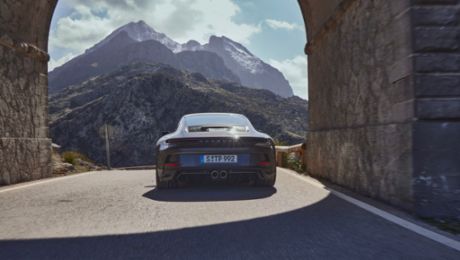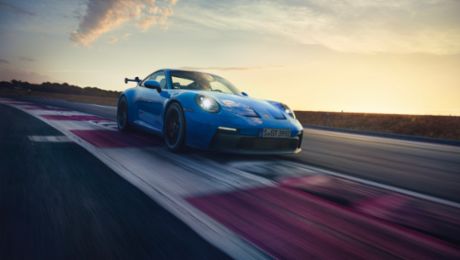For 25 years, every single Porsche 911 GT3 has embodied the essence of the company. Four generations of the uncompromising sports car continue the 911 success story, showcasing impressive performance both on the racetrack and on the road.
“In the 911 GT3, consistent lightweight construction meets outstanding driving dynamics and unmistakable design,” says Andreas Preuninger, Project Manager GT Vehicles. "Both the racing and road versions carry the Porsche DNA at their core and reflect the company’s motorsport experience. A bit of every victory from racetracks all over the world is contained in every GT3.”
At Porsche, it is also tradition that the series is built upon elements that have proven reliable even under the toughest conditions on the racetrack. The GT3 bears the hallmark of the Porsche motorsport department like no other 911. For 25 years, the road-approved sports car has outperformed itself in every new edition, becoming even faster, even more precise, even more dynamic. The racing versions of the 911 GT3 are also a success story. In the history books you will find a wealth of class and overall victories in major endurance races at the Nürburgring, Spa and Daytona. “The GT3 feels at home on the racetrack, but at the same time it is also a high-performance sports car suitable for everyday use,” according to Roland Kussmaul. For four decades, this Ludwigsburg native worked as a racing engineer, test and development driver at Porsche AG.
The evolution of a racing icon
In March 1999, Porsche presented the 911 GT3 with a power output of 265 kW (360 PS) at the Geneva International Motor Show. A few months later, the 996 generation of the 911 is available and follows in the footsteps of the iconic Carrera RS models. Under the bonnet of the first GT3 is a 3.6-litre engine, a further development of the six-cylinder naturally aspirated boxer engine from the 911 GT1. The final accolade was awarded to the two-time world rally champion Walter Röhrl, who drove the 302 km/h sports car over the 20.8 km-long Nordschleife of the Nürburgring in less than eight minutes.
This is the first time that a road homologation car has achieved this milestone. Seven minutes and 56.3 seconds of crisp sound and a remarkable high-revving exhilaration, to be precise. At 7,200 rpm, the engine delivers its maximum power and only at 7,800 rpm does the rev counter needle move into the red range. “This is the most exciting thing that Porsche is putting on the road at the moment,” says Röhrl after coming in under that magic eight-minute mark in the series production car. “The turning in the GT3 is very precise. This allows you to take all kinds of corners very quickly – I’ve generally only seen chassis tuning like this in motorsport.”
The internationally acclaimed road sports car follows three previous generations. Every three to four years, Porsche presents a new evolutionary stage, each showcasing the best innovations from motorsport. The first product upgrade to the 911 GT3 appeared in 2003 with an increase of 15 kW (21 PS). This upgrade worked on the principle of offering more power and more torque with the same displacement and fuel consumption. Three more years passed before the worldwide fan community of the puristic sports car got to celebrate an even more powerful output that exceeded 305 kW (415 PS), as well as a new maximum engine speed of 8,400 rpm. In addition to the high-speed concept, Porsche optimised the air supply for the six-cylinder boxer engine in the GT3 generation 997 to improve performance. In addition, for the first time ever, the sports car also featured an active suspension system in the form of Porsche Active Suspension Management (PASM).
When the 911 GT3 was next upgraded in 2009, the engineers increased the engine’s displacement to 3.8 litres and increased the power to 320 kW (435 PS). For an even more intense driving experience, they also improved the chassis components and aerodynamics. For example, they redesigned the rear wing and completely covered the underbody. This increased the downforce so effectively that the contact pressure more than doubled compared to the predecessor.
Third generation on the 50th anniversary of the Porsche 911
The third generation of the 911 GT3 celebrated its world premiere at the Geneva International Motor Show in 2013. Engine and gearbox, body and chassis – Porsche presented a complete redevelopment of the GT3 to mark the 50th anniversary of the 911. The 3.8-litre boxer engine delivered an output of 350 kW (475 PS) and reached a top speed of 315 km/h. The introduction of the Porsche dual-clutch transmission (PDK) in the GT3 was a revolution that enabled faster shift times and better performance. The new chassis with active rear-axle steering and other aerodynamic improvements made the 911 GT3 one of the most agile and precise 911s of all time. A lap on the Nürburgring-Nordschleife was possible in less than 7 minutes and 30 seconds.
It took four years for the sports car manufacturer to once again outperform itself with the next GT3. The six-cylinder boxer engine in this product upgrade grew to 4.0 litres displacement and provides 368 kW (500 PS). Customers could choose between the PDK and a six-speed manual sports transmission. The latter particularly appealed to purist drivers, as well as the optional touring package, which replaced the fixed rear wing with an automatically extending spoiler. The aerodynamic fine-tuning and the further developed chassis make the sports car an even more precise and powerful machine.
The current 911 GT3 is based on the 992 generation of the 911. With this sports car, presented in 2021, Porsche is continuing its tradition of setting standards in the high-performance sports car segment. The 4.0-litre six-cylinder boxer engine produces 375 kW (510 PS, 911 GT3 (2023): Fuel consumption* combined (WLTP) 13.0 – 12.9 l/100 km, CO₂ emissions* combined (WLTP) 294 – 293 g/km, CO₂ class G ). Innovative racing technologies such as the double wishbone front suspension and optimised aerodynamics with a distinctive swan-neck rear wing make the GT3 one of the most advanced 911s of all time. This generation combines motorsport technology with approval for road use in a way that is more powerful than ever before.
Even after 25 years, the 911 GT3 remains synonymous with sports performance and technological innovation. Porsche continues to make progress in order to continue the success story of the 911 GT3 with new models and technological leadership. As always, a passion for motorsport and enthusiasm for performance remains at the core of everything we do.
Other companions congratulate the 911 GT3 on its anniversary:
Andreas Preuninger – Project Manager GT Vehicles
‘Ever since my first experience with the 911 GT3, I have been completely fascinated by this car. It was ‘love at first drive’, back in 1999 as an instructor at the Porsche Sports Driving School. My affinity with this fabulous vehicle had a significant influence on my future career. From the second generation of the 996 GT3 onwards, I was able to help shape the further development of the 911 GT3 as project manager. Over the last 25 years, the GT3 has become more and more powerful and sporty and is certainly one of the most emotional sports cars ever. For me, there is no car I would rather drive. The strong connection between driver and vehicle is unique. Even after 25 years and seven generations, this has not changed, but has even increased. And it should stay that way in the future.’
Jörg Bergmeister – Test development driver for the 911 model series and Porsche brand ambassador
‘30 years ago, I had the honour of competing in my first race in a Porsche, in 1999 in the 911 GT3 Cup of the 996 generation. For me, a 911 GT3 is the perfect symbiosis of motorsport and road car. Porsche has taken many features from motorsport and brought them to the road with the GT3. The driver has to make very few compromises, driving pleasure and performance are always at the heart of it.’
Timo Bernhard – Overall Le Mans winner, team boss and Porsche brand ambassador
‘I've been fortunate enough to experience all 911 generations in racing. The 911 GT3 is my personal favourite model. I personally have many success stories in my career with it, from the Carrera Cup to victories as a Porsche Junior and, last but not least, the first DTM triumph for Porsche with the 991 generation 911 GT3 R in 2022. Over the past 25 years, every GT3 in its era has been a sports car that has brought the maximum possible performance and motorsport experience to the road.’
Walter Röhrl – Two-time rally world champion, development driver and Porsche brand ambassador
‘For me personally, the 911 GT3 is a racing car for the road. The 911 GT3 of the first generation 996 immediately reminded me of the 911 Carrera RS 2.7: With the GT3, driving performance and the engine were once again placed more in the spotlight. Alongside Roland Kussmaul, I was also able to be involved in the development of this model. For example, we advised against semi-slicks and recommended normal tyres. Speaking of normal tyres: I was able to set a new record directly with the GT3 on normal tyres. At the Nürburgring, I was able to beat the magic eight minutes for the first time with a series production car. The GT3 is now the dream car for every sporty, ambitious driver and fan.’



